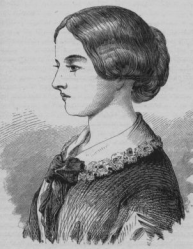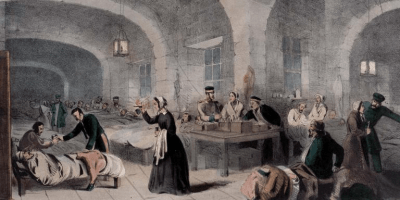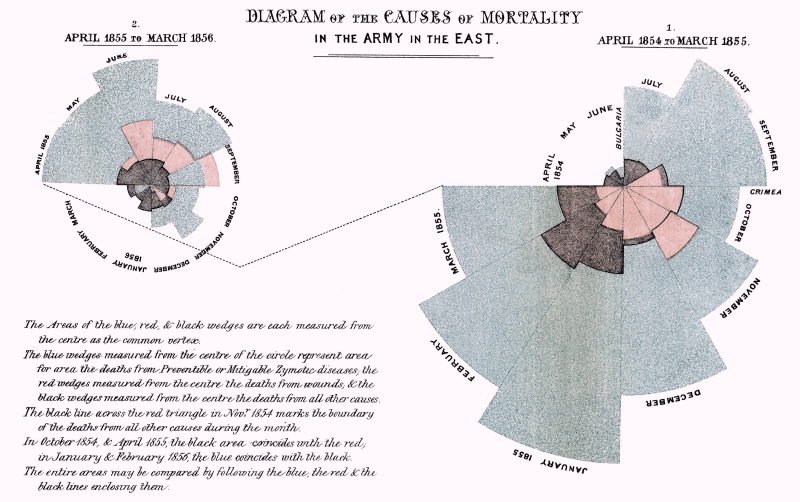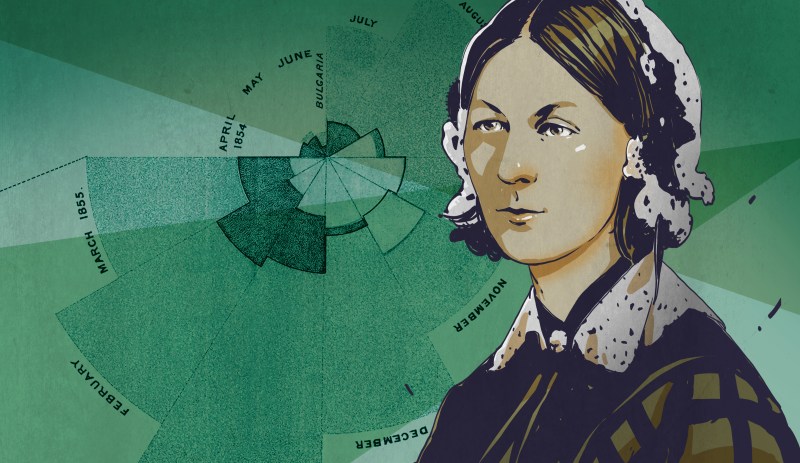When you think of Florence Nightingale, you probably imagine a nurse with a lamp, comforting soldiers. Indeed, Florence is considered the mother of modern nursing. But she also made serious contributions in statistical data analysis, and used the diagram named after her, the Nightingale rose diagram, to convince the British Parliament to enact sanitation reforms that saved hundreds of thousands, if not millions, of lives.
During the Crimean war, Florence worked around the clock as head nurse in an overcrowded field hospital. But she also found time to create graphs to illustrate the terrible conditions of that field hospital to members of British Parliament. The sanitation reforms she led greatly improved the life of the soldiers in battle, and widespread adoption of her hygienic practices vastly reduced mortality rates of humanity in general.

A Call from God
Florence Nightingale was born into a wealthy London family in 1820. Her father believed that women should be educated, and taught her several subjects himself. She was particularly good at math, but didn’t want to pursue a mathematical career. In fact, she didn’t know what she wanted to do, only that she didn’t want to live like a house cat in high society. Florence was miserable at home, and among her many writings she mentions praying for death. Instead of mercy, she got a calling to help the sick and wounded.
When Florence announced her intent to become a nurse, her family was completely devastated. Back then, hospitals were grim, filthy places, and most nurses were either widows, ex-servants, or women of bad character who couldn’t find other work. Nursing was not the sort of thing that rich, educated girls did with their lives.
Florence defied her family and left home to study nursing in Germany. She came back to London and started training nurses in a small hospital, where she was quickly promoted to superintendent. By this time her father had softened on the idea, and was secretly sending Florence a healthy allowance to help support her.

Triage in Turkey
Soon after the promotion, Britain and France declared war on Russia, and the Crimean war began. Reports of high mortality rates due to filthy field hospitals drove Florence into action.
She happened to be friends with Britain’s war secretary, and got herself and a team of three dozen volunteer nurses deployed to the Turkish base in Scutari where the British army was sending wounded soldiers. They set sail across the Black Sea from base camp in Balaclava, Ukraine, armed with a supply of medicines Florence bought with her own money.
Florence and her nurses found the conditions at this makeshift field hospital unspeakably bad. There were vermin crawling around everywhere, mass infections, and paltry supplies of even the simplest of medicines. More soldiers were dying from typhoid, cholera, and dysentery than from battle wounds. It was time to force the administration into action.
The Statistician of Scutari
At the time, the idea of representing information graphically was fairly new. Florence developed what’s now known as the polar area diagram or Nightingale rose diagram to show Parliament the various ways in which soldiers were dying, and to impress upon them that so many deaths were from preventable diseases. It’s essentially a pie chart, which was itself a fairly new concept, but adds a third dimension of time.

Her work, and her argumentation, was convincing. Through a series of letters, Florence explained that epidemics could be controlled with better nutrition, ventilation, and sanitation. The British government commissioned a pre-fab hospital that was built in England and shipped to Turkey. In the meantime, she enlisted the least infirm patients to help scrub the place from top to bottom, and set up a special kitchen to make meals for cholera and dysentery patients. Her efforts paid off greatly, and the mortality rate plummeted.
Working From Home
Florence returned from the war to a hero’s welcome, but she always shied away from attention and never gave any speeches. She turned down invitations left and right until one came in from Queen Victoria. Florence spent an entire afternoon telling the Queen and the prince consort all about the problems with Britain’s military hospitals. They were quite impressed, and when Florence asked for administrative attention on the British army in India, she got it.
Florence contracted brucellosis at Scutari and was mostly bedridden for the rest of her life. She never stopped working, and was frequently consulted about the design and maintenance of field hospitals until her death in 1910.
She fully rejected the life of leisure demonstrated by the women of her age, and rather than raising a family, she used her position to guide humanity into a better future. Florence transformed nursing into a skilled profession for women of good character and changed public opinion along the way.
















Something good that came out of Crimea, proper nursing practice. Something bad that come out of the Crimean war, cigarettes.
My wife is a nurse-doctor, yeah she has degrees in both fields, and her job is data driven with a lot of analytics as well as diagnostic work. She deals with the complex frequent presenters to the emergency department who usually have multifaceted issues that go beyond simple medicine. She also managed to have 5 children and avoid contracting brucellosis, not bad for a woman of color who immigrated from a third world country only 15 years ago. In fact the use of information visualisation to distil down complex processes and concepts for presentation to busy management types and medical directors was entirely her initiative. She probably wouldn’t see herself as a part of the hackaday cohort but the ethos of ad hoc problem solving and solutions development is very similar. I should show her what is possible with node-red and MQTT, perhaps if nothing else she can use it to model and simulate all of the interacting processes and service providers who interact with such patients, so that she can show what does and does not work, when a process blocks or the patient “falls through the cracks”.
I just want to express my appreciation for this interesting article without sounding dorky. Oops, too late.
Lady Ada,
Lady with Data,
got it!
I knew a little bit about her before (doesn’t everyone) but this, wow, truly a remarkable woman, we could use more of her kind.
There is a museum dedicated to her life.
It is located next to the hospital across the Thames from Parliament.
This has nothing to do with Hackaday topics.
Nurses are bold, and capable and independent. They often problem solve, figuring out how to accomplish something rather than have someone tell them exactly what to do.
It’s often an awful time, in the hospital or needing medical attention. The nurses aren’t there to keep you company, but they often take time to explain things, and sometimes just by being themselves they make things better.
Personally, I found this article interesting and I was happy to read about her, but Dave is right; This article has no place on Hackaday. You can metaphor as hard as you want but this is a completely unrelated topic.
It fits in with their Women Pioneers in Science series.
Thanks for your in-depth and thoughtful analysis /s
Well known historical figure with a backstory on data visualization that was previously unknown to me? Sounds like a great Hackaday topic. Did you read the article before leaving your comment?
Honestly I feel like the writers can decide for themselves what they can and can’t write. If you don’t like it don’t read it. Some of my favorite articles aren’t “hardware hacks” and really make you think. There are still plenty of “fresh hacks everyday” to go around. I prefer quality over quantity anyway.
The hospital in Scutari (nowadays Üsküdar) is actually a museum now, I was expecting it to be gone by now. Also there are a few modern hospitals named after her in the area, but I had never thought about it before, I guess.
> the life of leisure demonstrated by the women (from wealthy families) of her age
Fixed that massive mistake for you.
Point taken. But did you read the _entire_ second section? The first sentence starts off with “wealthy family” and goes on from there. There’s only so many times you can say she’s rich.
She was rich; born into it.